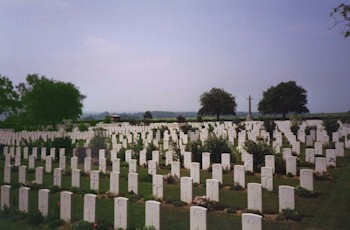|
|
| Home Topics Memorials Miscellany Transcripts References Family History Glossary Latest Beeston Blog About us | Site Search |
|
Samuel Bagshaw was born in Sneinton, Notts in about 1885, the son of Samuel & Elizabeth Bagshaw. In 1904, he married Mary Ann Riley and, it appears. they lived at various addresses, including Breaston and Long Eaton, Derbyshire and Radford, Nottingham where four children were born2. In April 1911, they were living at Main Road, Chilwell, Notts but appear to have moved again to live at 44 Oxford Terrace, Windsor Street, Beeston3. In 1911, Samuel was working as a self-employed window cleaner. The Bantam Battalions were the brainchild of Albert Bigland MP, Chairman of Birkenhed City Recruiting Committee when he suggested that all able bodied men of below the qualifying height of 5’ 3" should be formed. By mid February 1915, a unit to be known as the 15th (Service) Battalion Sherwood Foresters was formed in Nottingham by the Mayor and a committee, as an all "Bantam" battalion and joined the 105th Brigade 35th Division which was part of the No 6 Recruiting District. Samuel Bagshaw was one of the first to enlist when newly formed 15th Battalion Sherwood Foresters started recruiting in February 1915. In June 1915, the 15th Battalion found themselves at Masham in Yorkshire where they became part of the 105th Brigade 35th all bantam division. After training at various camps in England the Division was sent to France in January 1916. Private Bagshaw was involved in all the action and was lucky to survive the "Somme Battles" when on July 19th there were many casualties in the battalion. He was not however so lucky a year later; he was killed in action in a raid near Guillemont Farm, In August 1917, approval was given early in the month for a major undertaking involving a raid on Gillemont Farm and the capture of a commanding position known as "The Knoll" and instruction was given to the 15th Battalion, as part of the 105th Brigade, to undertake this task. After extensive artillery fire the battalion advanced at 0400 hrs on the 19th August. When the barrage lifted and the battalion reached the enemy position they found the artillery had done their job and hand-to-hand fighting continued until the Germans were driven back. The assault was over in some fifteen minutes and by 0540 hrs the companies returned with their wounded and a few prisoners. Three of the wounded were at the hands of the Royal Flying Corps who machined gunned them down unaware they were firing at their own.4. Private Bagshaw died about a week later, as a result of wounds received during this action and enemy shellfire. It was just before the battalion was due to be relieved by the 14th Gloucester Regiment. He is now buried in Tincourt New British Cemetery. Tincourt New British Cemetery - Tincourt is a village about 7 kilometres east of Peronne and Tincourt New British Cemetery is on the west side of the village, just off the D199. The villages were occupied by British troops in March, 1917, during the German Retreat to the Hindenburg Line; and from the following May until March, 1918, Tincourt became a centre for Casualty Clearing Stations. On the 23rd March, 1918, the villages were evacuated; and they were recovered, in a ruined condition, about the 6th September. From that month to December, 1918, Casualty Clearing Stations were again posted on the site of Tincourt. The cemetery was begun in June, 1917, and used until September, 1919; the few German burials, during their occupation of the village, are in Plot VI, Row A. After the Armistice it was used for the reburial of soldiers found on the battlefield, or buried in small French or German cemeteries. The graves of 136 American soldiers, buried here in the autumn of 1918, and one who died in December, 1917, and those of two Italian soldiers have been removed to other cemeteries. There are now nearly 2,000, 1914-18 war casualties commemorated in this site. Of these, over 250 are unidentified and special memorials are erected to seven soldiers from the United Kingdom and one from Australia, known or believed to be buried among them. Other special memorials record the names of 21 soldiers from the United Kingdom, two from Canada, one from Australia and one from South Africa, buried in other cemeteries, whose graves were destroyed by shell fire. The cemetery covers an area of 6,149 square metres. The following were among the graveyards from which British graves were concentrated to Tincourt New British Cemetery:
Footnotes 1The photograph of Tincourt New British Cemetery is from the Commonwealth War Graves Commission website. (http://www.cwgc.org) 21911 Census - Piece 1244 RD434 SD4 ED1 Schedule 44 - Main Street, Chilwell, Notts. Apparent previous places of residence can be tracked based on their children's birth places : Sydney (b. 1905, Breaston, Derbys), Ruth (b. 1907), Samuel (b. 1909 Long Eaton, Derbys) and Ethel b. 1911 Radford, Notts) 3This address is given for his widow in the Commonwealth War Graves Commission records. His parents are there described as "of Nottingham" 4The account of the battle is based on "The Blast of War" - a History of Nottingham’s Bantams, 15th (Service) Battalion Sherwood Foresters, 1915-1919 by Maurice Bacon and David Langley. (Published by Sherwood Press Nottingham Ltd, 1986). 5The desciption of Tincourt New British Cemetery is based on that on the Commonwealth War Graves Commission website. (http://www.cwgc.org) |
|
||||||||||||||
|
|
||||||||||||||||
